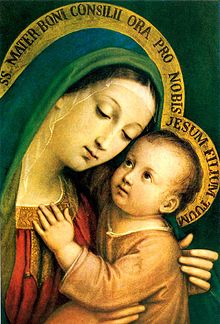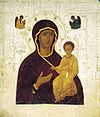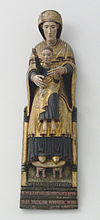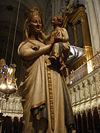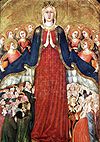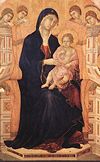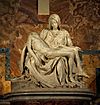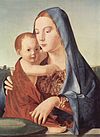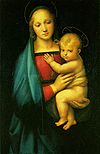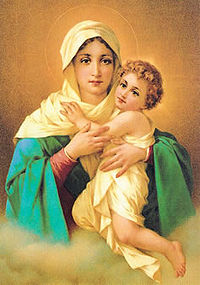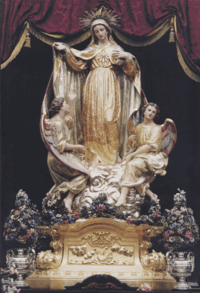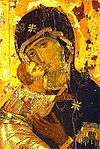- Titles of Mary
-
A series of articles on

mother of Jesus
Chronology
Presentation of Mary
Annunciation · Visitation · Virgin Birth · Nativity · Presentation of Jesus · Flight into Egypt · Finding in the Temple · Cana · Crucifixion · Resurrection · PentecostMarian Perspectives
Roman Catholic
Eastern Orthodox • Anglican • Lutheran • Protestant • Muslim •Catholic Mariology
Mariology • History of Mariology • Papal teachings • Mariology of the saintsDogmas and Doctrines
Mother of God • Assumption • Immaculate Conception • Perpetual VirginityMary in Culture
Titles
• Feasts • Art • MusicMary is known by many titles (Blessed Mother, Virgin, Madonna, Our Lady), epithets (Star of the Sea, Queen of Heaven, Cause of Our Joy), invocations (Theotokos, Panagia, Mother of Mercy) and other names (Our Lady of Loreto, Our Lady of Guadalupe).
All of these titles refer to the same individual named Mary, the mother of Jesus Christ (in both the New Testament and Qur'an) and are used variably by Roman Catholics, Eastern Orthodox, Oriental Orthodox, and some Anglicans. (Note: Mary Magdalene, Mary of Clopas, and Mary Salome are different individuals from Mary, mother of Jesus.)
A few of the titles given to Mary are dogmatic in nature, referring to Marian beliefs that the Church views as necessary for salvation. Many other titles are poetic or allegorical and have lesser or no canonical status, but which form part of popular piety, with varying degrees of acceptance by the clergy. Yet more titles refer to depictions of Mary in the history of art.
Historical and cultural context
- See also :History of Roman Catholic Mariology
There are several theories on the significance of the relatively large number of titles given to Mary.[1][2] Some titles grew due to geographic and cultural reasons, e.g. through the veneration of specific icons. Others were related to Marian apparitions.
Given the large spectrum of human needs in varied situations, Mary's help was and is sought for all of them. This led to the formulation of many of her titles (good counsel, help of the sick, etc.). Moreover, meditations and devotions on the different aspects of the Virgin Mary's role within the life of Jesus led to additional titles such as Our Lady of Sorrows.[3] Still further titles have been derived from dogmas and doctrines, e.g. Queen of Heaven or the Immaculate Conception.
Mary's cultus or "devotional cult" consolidated in the year 431 when, at the Council of Ephesus, "Nestorianism", which asserted Christ's dual nature, was anathematized and the Theotokos, or Mary as bearer of God, was declared dogma. Henceforth Marian devotion—which centered on the subtle and complex relationship between Mary, Jesus, and the Church—would flourish, first in the East and later in the West.
The Reformation diminished Mary's role in many parts of Northern Europe in the 16th and 17th centuries. The Council of Trent and Counter Reformation would intensify Marian devotion in the West. Around the same period, Mary would become an instrument of evangelization in the Americas and parts of Asia and Africa, e.g. via the apparitions at Our Lady of Guadalupe which resulted in a large number of conversions to Christianity in Mexico.
Following the Reformation, as of the 17th century, the baroque literature on Mary experienced unforeseen growth with over 500 pages of Mariological writings during the 17th century alone.[4] During the Age of Enlightenment]], the emphasis on scientific progress and rationalism put Catholic theology and Mariology often on the defensive in the later parts of the 18th century, to the extent that books such as The Glories of Mary (by Alphonsus Liguori) were written in defense of Mariology. The 20th century was dominated by a genuine Marian ethusiasm both at the papal and popular levels. The 20th century witnessed significant growth in Marian devotions and a dramatic rise in membership in Marian Movements and Societies.
In English
Frequently used titles for Mary in the English-speaking world include
- The Virgin
- The Virgin Mary
- The Blessed Virgin Mary
- The Blessed Mother
- Mother of God
- Immaculate Mary
- Saint Mary
- Holy Mary
- Holy Virgin
- Our Lady
- The Madonna
- Notre-Dame
- Queen of Heaven
Early titles of Mary
English Latin Greek Notes Mary Maria Mariam (Μαριάμ), Maria (Μαρία) Arabic: Maryām (مريم), Chinese: (瑪利亞), Coptic: Mariam, French: Marie, German: Maria, Italian: Maria, Judeo-Aramaic: Maryām (מרים), Maltese: Marija, Portuguese: Maria, Russian: Marija (Мария), Spanish: María, Syriac: Mariam, Vietnamese: Maria; Marija "Full of Grace", "Blessed", "Most Blessed" Gratia plena, Beata, Beatissima kecharitomene[5] (κεχαριτωμένη) from the angel's greeting to Mary in Luke 1:28; "Virgin", "the Virgin" Virgo Parthenos[6][7] (Παρθένος) Greek parthenos used in Matthew 1:23; Ignatius of Antioch refers to Mary's virginity and motherhood (ca. 110); "Cause of our Salvation" causa salutis[8] according to Irenaeus of Lyons (150–202); "Advocate of Eve" advocata Evæ[9] " " ; "Mother of God" Mater Dei Meter Theou (Μήτηρ Θεοῦ) often abbr. ΜΡ ΘΥ in Greek iconography; "God-bearer" Deipara, Dei genetrix Theotokos (Θεοτόκος) lit. "one who bears the One who is God"; a common title in Eastern Christianity with christological implications; adopted officially during Council of Ephesus (431) in response to Nestorianism, which questioned the Church's teaching that Jesus Christ's nature was unified; "Ever-virgin" semper virgo aie-parthenos[6] (ἀειπάρθενος) "Holy Mary", "Saint Mary" Sancta Maria Hagia Maria[6] (Ἁγία Μαρία) Greek invocation is infrequent in contemporary Eastern Christianity;[10] "Most Holy" Sanctissima, tota Sancta[11] Panagia (Παναγία) "Most Pure" Purissima "Immaculate" immaculata akeratos[6] (ἀκήρατος) "Lady", "Mistress" Domina Despoina[6] (Δέσποινα) related, "Madonna" (Italian: Madonna, from ma "my" + donna "lady"; from Latin domina); also, "Notre Dame" (French: Notre Dame, lit. "our lady"); "Queen of Heaven" Regina Coeli, Regina Caeli Mary is identified with the figure in Revelation 12:1; "Star-of-the-Sea" stella maris attributed to St. Jerome; "Seat of Wisdom" Sedes sapientiae "Cause of Our Joy" Causa nostrae laetitiae "Help of Christians" Auxilium christianorum Image Type Typical Art Style Description Hodegetria
"She Who Shows the Way"Byzantine Mary holds Christ in her left hand and with her right hand she "shows the way" by pointing to Him; Sedes Sapientiae
"Throne of Wisdom"Romanesque Christ is seated in His mother Mary's lap, symbolically the "Throne of Wisdom"; "Gothic Madonna"
Gothic Based loosely on Byzantine Hodegetria iconography; typically depicts a standing, smiling Mary and playful Christ Child; considered one of the earliest depictions of Mary that is strictly Western;[12] Madonna Lactans
"Our Lady Nursing"Renaissance, and others The Virgin is depicted breastfeeding the Holy Infant. One of the earliest depictions (if not the earliest depiction) of Mary, is Our Lady nursing, as painted in the Priscilla Catacombs ca. A.D. 250;[13] Mater Misericordiae
"Mother of Mercy"Gothic, Renaissance, Baroque A regal, celestial Mary is depicted covering the faithful in her protective mantle; first arose in the late 13th century in Central Europe and Italy; depiction is commonly associated with plague monuments.[14] Maestà
"Majesty"
of the Virgo Deipara
"Virgin God-bearer"Gothic Mary is seated in majesty, holding the Christ Child; based on Byzantine Nikopoia iconography; Pietà
"Pity"
of the Mater Dolorosa
"Mother of Sorrows"Gothic, Renaissance, Baroque Mary cradles the dead body of Jesus Christ after his crucifixion; this type emerged first in the 13th century in Germany as an Andachtsbild or devotional icon relating to grief; Italian Pietàs appeared in the 14th century;[15] Michelangelo's Pietà (1498–1499) is considered a masterpiece; Mater Amabilis
"Loving Mother"
commonly, "Madonna and Child"Renaissance, Baroque Iconic Western depiction with many variations; based loosely on Byzantine Glykophilousa ("sweet kisses") iconography; Mary turns her gaze away from the Christ Child as she contemplates His future Passion; Renaissance emphasis on classical ideal types, realistic human anatomy, and linear perspective are evident; Dogmatic titles
- Mother of God
- Virgin Mary*
- Immaculate Conception*
- Assumption*
Names of Mary associated with devotions or apparitions
General articles
Overview of Mariology •
Veneration of the Blessed Virgin • History of MariologyExpressions of devotion
Art • Hymns • Music • ArchitectureSpecific articles
Apparitions • Saints • Popes • Societies • Hearts of Jesus & Mary • Consecration to MaryDevotional titles
Most of the devotional titles are contained in the Loreto Litanies:[16]
- Holy Mary
- Holy Mother of God
- Holy Virgin of Virgins
- Mother of Christ
- Mother of the Church
- Mother of Divine Grace
- Mother Most Pure
- Mother Most Chaste
- Mother Inviolate
- Mother Undefiled
- Mother Most Amiable
- Mother Admirable
- Mother of Good Counsel
- Mother of Our Creator
- Mother of Our Redeemer
- Mother of Mercy
- Virgin Most Prudent
- Virgin Most Venerable
- Virgin Most Renowned
- Virgin Most Powerful
- Virgin Most Merciful
- Virgin Most Faithful
- Mirror of Justice
- Seat of Wisdom
- Cause of Our Joy
- Spiritual Vessel
- Vessel of Honor
- Singular Vessel of Devotion
- Mystical Rose
- Tower of David
- Tower if Ivory
- House of Gold
- Ark of the Covenant
- Gate of Heaven
- Morning Star
- Health of the Sick
- Refuge of Sinners
- Comfort of the Afflicted
- Help of Christians
- Queen of Angels
- Queen of Patriarchs
- Queen of Prophets
- Queen of Apostles
- Queen of Martyrs
- Queen of Confessors
- Queen of Virgins
- Queen of All Saints
- Queen Conceived Without Original Sin
- Queen Assumed Into Heaven
- Queen of the Most Holy Rosary
- Queen of Families
- Queen of Peace
Other titles:
- Co-Redemptrix
- Destroyer of Heresy
- Empress of the World
- Favoured Daughter of the Father
- Immaculate Heart of Mary
- Joy of the Just
- Mother of the Poor
- Mother of the Word
- Mother of Orphans
- Mother of Perpetual Help
- Mother of Sorrows
- Mother of the Son
- Mother Thrice Admirable
- Nova Eva (the New Eve)
- Our Lady of Confidence
- Our Lady of Victory
- Queen of Heaven
- Ravisher of Hearts
- Spouse of the Holy Spirit
- Star of the Sea
- Tabernacle of the Lord
- Temple of the Most Holy Trinity
- Treasure House of God's Graces
- Untier of Knots
Names and titles of Mary in Islam
The Qur'an refers to Mary by the following titles:
- Qānitah - the Arabic term implies the meaning, not only of constant submission to Allah, but also absorption in prayer and invocation.
- Siddiqah - "She who accepts as true" or "She who has faith". The term has also been translated "She who believes sincerely totally".
- Sājidah - "She who prostrates to Allah in worship"
- Rāki’ah - "She who bows down to Allah in worship"
- Tāhirah - "She who was purified"
- Mustafia - "She who is chosen"
- Nur - Mary has been called Nut (Light) and Umm Nut (the mother of one who was Light)
- Sa’imah - "She who fasts"
- Ma'suma - "She who never sinned"
See also
- Agni Parthene
- Epithet
- Intercession of the saints
- Litany of the Blessed Virgin Mary
- Marian apparitions
- Veneration
Citations
- ^ Univ of Dayton
- ^ Orthodox titles
- ^ The thousand faces of the Virgin Mary by George Henry Tavard, 1996 ISBN 0814659144 page 95
- ^ A Roskovany, conceptu immacolata ex monumentis omnium seculrorum demonstrate III, Budapest 1873
- ^ "...Byzantine inscriptions from Palestine...in the sixth [century]....fourteen inscriptions invoke "Holy Mary" (Hagia Maria), eleven more hail her as Theotokos; others add the attribution of "Immaculate" (Akeratos), "Most Blessed" (Kecharitomene), "Mistress" (Despoina), "Virgin" or "Ever-Virgin" (Aei-Parthenos)." (Frend 1984, p. 836)
- ^ a b c d e Frend 1984, p. 836.
- ^ "Blue Letter Bible" lexicon results for parthenos Retrieved December 19, 2007.
- ^ Irenaeus of Lyons (Adversus Haereses 3.22.4).
- ^ Irenaeus of Lyons (Adversus Haereses 5.19.1]): "And if the former did disobey God, yet the latter was persuaded to be obedient to God, in order that the Virgin Mary might become the patroness (advocata) of the virgin Eve. And thus, as the human race fell into bondage to death by means of a virgin, so is it rescued by a virgin; virginal disobedience having been balanced in the opposite scale by virginal obedience."
- ^ Orthodox Holiness :: The Titles Of The Saints
- ^ http://www.uni-mannheim.de/mateo/camenaref/hofmann/p/books/p_408.html
- ^ Madonna. (2008). In Encyclopædia Britannica. Retrieved February 17, 2008, from Encyclopædia Britannica Online: [1]
- ^ http://www.catacombepriscilla.com/pagine-eng/regina.htm
- ^ Jeep 2001, p. 393.
- ^ Watts, Barbara. "Pietà". Grove Art Online. Oxford University Press, Retrieved February 17, 2008, http://www.groveart.com/
- ^ "The Loreto Litanies". The Holy See. http://www.vatican.va/special/rosary/documents/litanie-lauretane_en.html. Retrieved 2011-11-07.
References
- Frend, W. H. C. (1984). The Rise of Christianity. Fortress Press. ISBN 0800619315.
- Jeep, John M. (2001). Medieval Germany: An Encyclopedia. Routledge. ISBN 0824076443.
External links
- Archaeological project to collect all epithets of Mary in Greek, Latin, and Syriac
- List of 6,000 Catholic titles of Mary
- Roman Catholic understanding of Marian titles
- Eastern Orthodox understanding of saints' titles
Virgin Mary, Mother of Jesus General Mariology Roman Catholic · Anglican · Eastern Orthodox · Ecumenical (Christian) · Protestant · Lutheran · Muslim ·
Life in the Bible Annunciation · Visitation · Magnificat · Nativity · Temple Presentation of Jesus · Flight into Egypt · Finding in the Temple · Cana · Crucifixion · Deposition · Pentecost
Life in Tradition Lists Antiphons · Apparitions · Devotions · Devotions, May · Feasts · Hymns · Patronage · Shrines · Titles
Miscellaneous Titles Categories:
Wikimedia Foundation. 2010.

